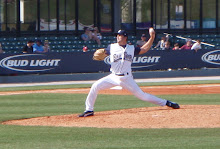 One of the trade marks of the "Intelligent Pitcher," is his ability to disrupt a hitter's timing by changing speed with his pitches. Most take this to mean using a change-up to slow down a hitter and get him on his front foot. Today, however, I am hear to discuss the benefits of being able to change speeds with your fastball alone. If given the chance, study a game pitched by Greg Maddux, Brandon Webb, or Tom Glavine, and notice the radar gun readings on their fastballs alone. Chances are, they will vary by as much as 8 mphs. Trust me, that is not just an accidental variation.
One of the trade marks of the "Intelligent Pitcher," is his ability to disrupt a hitter's timing by changing speed with his pitches. Most take this to mean using a change-up to slow down a hitter and get him on his front foot. Today, however, I am hear to discuss the benefits of being able to change speeds with your fastball alone. If given the chance, study a game pitched by Greg Maddux, Brandon Webb, or Tom Glavine, and notice the radar gun readings on their fastballs alone. Chances are, they will vary by as much as 8 mphs. Trust me, that is not just an accidental variation.The Intelligent Pitcher will purposely throw his fastball slower at certain points in an at bat to entice a hitter to swing as if it were a regular fastball, usually resulting in a ground out or wiff! This is the BP Fastball, or "Batting Practice Fastball." The reason this pitch is so effective is because the hitter sees the same arm action as a regular fastball and the spin is also the exact same, thus leading to a swing. Since the pitch is thrown a few mph's slower though, he will be out in front. Obviously, a pitcher must establish his regular fastball atleast once or twice in an at bat or earlier in the game (to the same hitter) so that the hitter is fooled by the change of speed. Typically, if thrown correctly, the BP Fastball will have more sink and movement than the regular fastball. It is great for inducing groundballs with the movenment or pop ups from the velocity change.
Throwing the BP Fastball correctly actually takes more guts than anything, as it requires a lot of courage to throw a fastball that starts down the middle that you WANT a hitter to hit. The grip is essentially a regular 2-seam
 grip with your fingers spread slightly wider so that both fingers rest on top of or slightly outside of the seams. The pitcher must do his best to maintain as close to his regular arm-speed as possible but without the same finshish and whip. The key here is to use the glove and front side as aggressively as with the regular fastball. This movement is one of the first things a hitter senses and must be kept the same. The best times to throw this pitch are in fastball counts (not the first pitch of an at bat) where you want to get back ahead of the count (1-1, 1-0, 2-1, 3-1) when you are certain the hitter is going to swing if he gets his fastball.
grip with your fingers spread slightly wider so that both fingers rest on top of or slightly outside of the seams. The pitcher must do his best to maintain as close to his regular arm-speed as possible but without the same finshish and whip. The key here is to use the glove and front side as aggressively as with the regular fastball. This movement is one of the first things a hitter senses and must be kept the same. The best times to throw this pitch are in fastball counts (not the first pitch of an at bat) where you want to get back ahead of the count (1-1, 1-0, 2-1, 3-1) when you are certain the hitter is going to swing if he gets his fastball.So the next time you're in a jam and need to fool a hitter, even if you don't have command of your change up that day, spin a BP Fastball in there. Trust me on this one, because it truly is a gutsy pitch.
Leave a comment with any questions you may have and I'll be happy to explain further.
Stay tuned for the next blog for Less is More's first "Big Leaguer Breakdown" where I'll post a video of a major leaguer and discuss in detail the benefits and drawbacks of his mechanics!
Image Sources: http://z.about.com/d/baseball/1/0/F/9/-/-/twoseam2.jpg and http://i2.cdn.turner.com/si/2008/writers/tom_verducci/12/06/maddux/greg-maddux..si.jpg

Forrest, Great site. We are glad you are back in the Burg. EA looks forward to working with you and the Venom travel team also looks forward to you assisting them in becoming better pitchers as they grow older..
ReplyDeleteForrest this is a great site. Now that I know its here I will be checking it out. Thanks for teaching Chase everything he knows so far. I know he cant wait for the next lesson each week. It was fun sitting back watching Chase and EA do work last spring and they learned it all from you.
ReplyDeleteI know that we are glad your back!!!!
Glad you guys like the site so far...feel free to post any questions or possible Blog topics...I plan on keeping this going and eventually starting a website to go with.
ReplyDelete